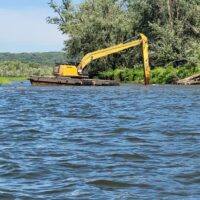“Impacts of the Tentatively Selected Plan – During construction of the TSP there would be minor adverse effects to aquatic habitat, mostly due to sediment resuspension. There would also be a long-term reduction in available aquatic habitat as a result of constructing about 50 acres of peninsulas and mudflat.
As discussed in Section3.6.4,there would be a negligible impact to aquatic habitat in Lake Pepin as a result of redirecting sediment loading from some of the project area downstream to Lake Pepin.
One area currently providing quality aquatic habitat is the Catherine Cut. That sidechannel contains large woody debris, water depths, and flows that provide habitat for riverine fish species.
Under the TSP,an access channel would be dredged through the cut to allow efficient barge access for construction equipment and materials to the project area. This dredging and disturbance would change the habitat conditions in the cut. When the project is complete though, the flows through the cut should approximate the existing conditions, and deeper areas may still provid equality habitat for riverine species. Large woody debris would also likely
continue to be trapped in the deeper areas to provide similar habitat to what is there now. So while project construction would have adverse effect on this side channel in the short-term, the long term effects are unknown and may or may not be adverse.
In total and in the long term, the project features are designed to benefit aquatic habitat; therefore, there would be substantial long-term beneficial effects to the remaining 595 acres of aquatic habitat evaluated (see Appendix D – Habitat Evaluation and Quantification).”
10. Review and Comment. If you have any comments on the environmental assessment they should be provided before the expiration date of this notice. Persons submitting comments are advised that all comments received will be available for public review, to include the possibility of posting on a public website. Questions on the project or comments on the Environmental Assessment can be directed to Steve Clark, project biologist at (651) 290-5278 or at [email protected]. Please address all formal written correspondence on this project to District Commander, St. Paul District, Corps of Engineers, ATTN: Regional Planning and Environment Division North, 180 Fifth Street East, Suite 700, St. Paul, Minnesota 55101-1600.
Your $24,000,000.00 at work.
